#allodaposuchus
Text
Prehistoric Planet Croc Ideas
So this was a thing I did on Twitter in anticipation of Prehistoric Planet. Obviously crocs (in this case meaning crocodylomorphs) were a pretty massive part of earth's fauna during the late Cretaceous, and seeing as the first season featured NONE I came to speculate which taxa could hypothetically make an appearance.
Now part of the challenge for myself was to come up with a new, interesting contender every day in anticipation of the show's release, each based around the confirmed episides we had and restricted purely to taxa from the Campanian and Maastrichtian. While it took a lot of energy, I did manage to do so. Hell, halfway through they dropped the reveal of Simosuchus, which I had saved for later.
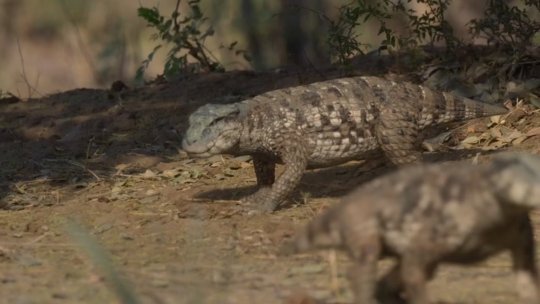
Obviously we didn't get much still, but I'll regardless post my list of candidates and ideas here, perhaps third time's the charme for a lot of these (tho for convenience I'm still ordering them by S2s episode titles). I'll also try to break them apart roughly by biome, starting with islands.
PS: I'd love to hear which crocs people would have loved to see themselves. Any on this list or stuff I didn't even mention? Let me know I'm curious.

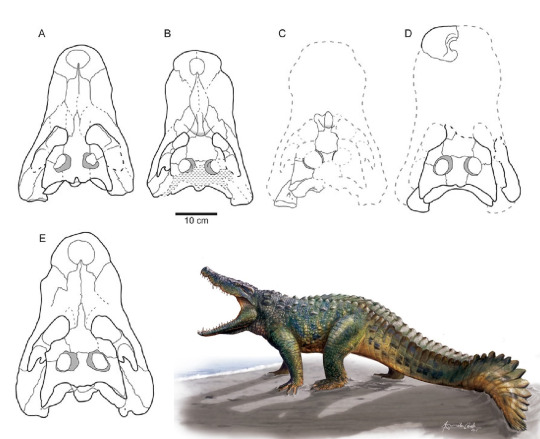

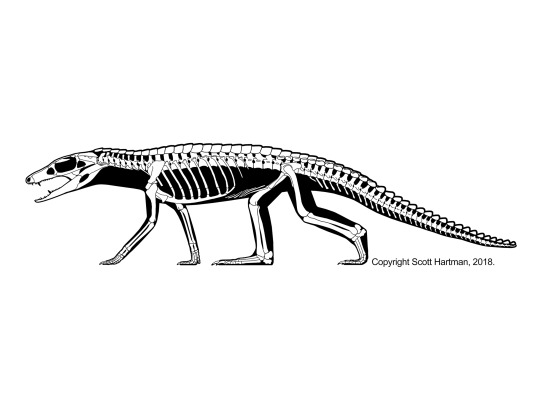

We got a shit ton of island crocs from the Cretaceous actually, which you can broadly divide into two categories.
The crocodiles of the European archipelago as seen in the top row.
Featuring the small, possibly shellfish eating Acynodon (art by Adramelech89), the incredibly widespread Allodaposuchus which did have some possibly semi-terrestrial forms (art by Alejandro Blanco, Aina and Agnès Amblás) and Aprosuchus, a tiny terrestrial critter from Hateg (art by @knuppitalism-with-ue). They already give a nice diversity between tiny durophages with blunt snouts, large, more traditional crocs and lanky land species.
The other island category concerns Madagascar, which had a lot of attention in season 2. Discounting Simosuchus, we got Araripesuchus tsangatsangana (art by Scott Hartman) and Mahajangasuchus (art by Mark Hallet). Both are really cool. The former is yet another smaller terrestrial species that may not actually be part of Araripesuchus, while the later is a massive, 4 meter relative of the famous Kaprosuchus that took to the water independently from all other crocs and has been nicknamed "Hippo croc" for its weird skull. Really I'd have loved to seen an episode entirely dedicated to this place.
Next up we had the badlands episode, which oh boy has a lot of contenders from the clade Notosuchia. Brace yourself.
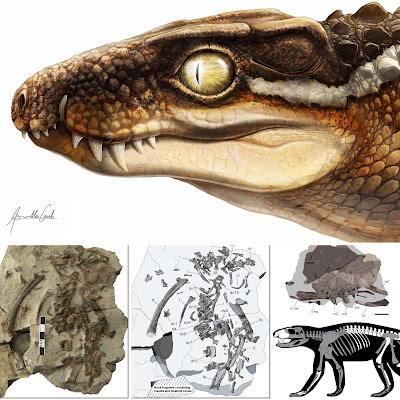


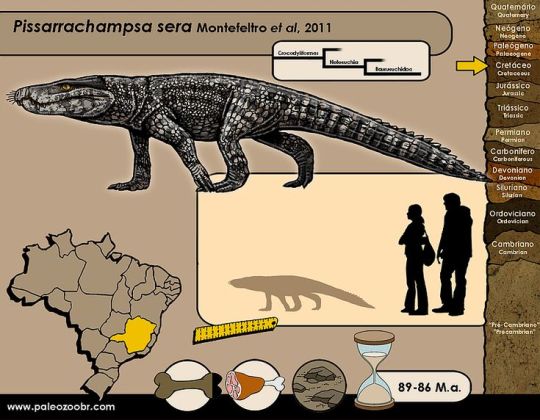


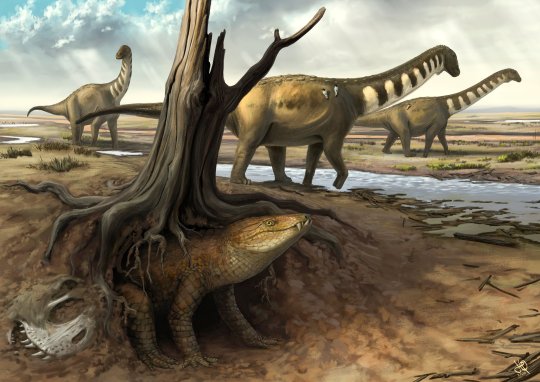

Here again I could split these in two categories.
The first is just general badland taxa. There's Ogresuchus for example, from Spain's Tremp Formation (art by Aina and Agnès Amblás). A relatively small sebecid found in a sauropod nesting site. And we all know what PhP does with baby sauropods. Or the long-necked Gobiosuchus (art by @yoofilos) from Mongolia, which may look like its related to the other ones in this category but actually is a far more ancient type of croc.
The far bigger group concerns South America's Notosuchians. ALL OF THESE are from the Bauru Group, with some even from the same single formation. You got Stratiotosuchus (again by Joschua Knüppe), a large terrestrial baurusuchid that filled the nische of mid sized carnivore in an environment shared by sauropods and abelisaurs. There's Pissarrachampsa (by Felipe Alves Elias), another baurusuchid I decided to feature because we have evidence of a nesting site that shows they only had few eggs. A great opportunity to show their tender side. Uberabasuchus (justin_an74), part of the bizzarly proportioned peirosaurids. Adamantinasuchus (by Deverson da Silva), a small, lanky Notosuchian and of course the heavily armored omnivore Armadillosuchus (by the ever talented Júlia d'Oliveira). Hell you could do a full episode just on the foodweb of the Bauru Group (Godoy et al. 2014).
Then there's swamps, which I'll just use to dump all the crocs that don't fit into the other categories.
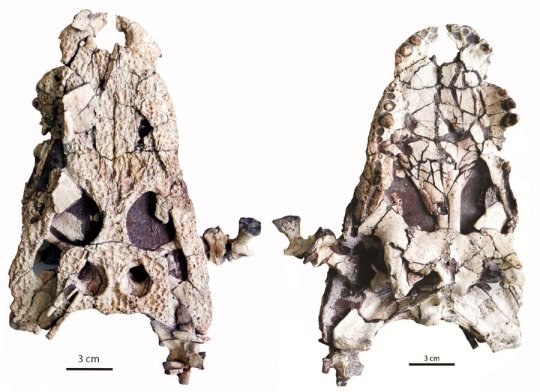


As you'd expect, freshwater would be ideal for crocs with a more traditional semi-aquatic lifestyle, here represented by three forms. Jiangxisuchus (image by Li et al. 2014) is a paralligatorid, which are tiny crocodilians from the Cretaceous and Paleogene of east Asia. We honestly don't know what they are, some say alligator relatives, others say they are closer to crocs. But its small and cute. Then there's Roxochampsa (artist of the model I couldn't find), which looks suspiciously crocodilian but is actually a relative of Uberabasuchus from the badlands, hell it appeared in the same formation. Still, I reasoned that I'd throw it into this category because I already proposed so much for badlands (none of which came true but hey). And then there's Denazinosuchus (art by Andrey Atuchin). Again it looks deceptively like a modern croc, but is actually the last remnant of the goniopholids, crocodyliforms that were prominent animals in the Jurassic and early Cretaceous. It could have brought both taxonomic diversity nad highlighted croc resilience till the end.
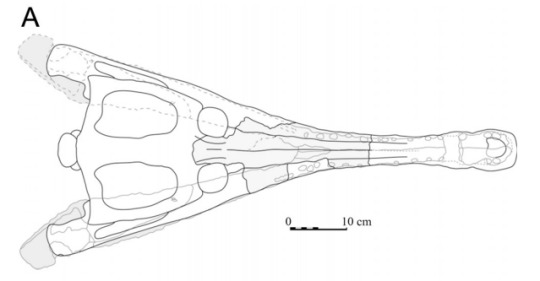

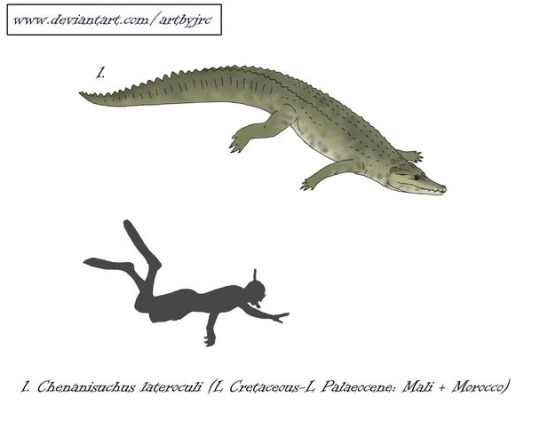
When it came to picking out crocs for Oceans, it got tricky. Obviously season 2 tried to differentiate itself by being set more in the open ocean, not the coast, and true pelagic crocodiles weren't around by the end of the Cretaceous. So I had to settle for coastal animals. There's Sabinosuchus (Schiller II et al. 2016), a cousin to Sarcosuchus and, like Denazinosuchus, one of the last of its lineage. Also its from Mexico which is rarely talked about for its fossils. Rhabdognathus (Ghedoghedo) is a distant cousin, a slender snouted dyrosaur. Unlike pholidosaurs, dyrosaurs actually did really well after the KPG impact and spread around a lot, living way into the Eocene. And finally Chenanisuchus (art by artbyjrc), which like Rhabdognathus was found both before and after the impact that killed the dinosaurs.

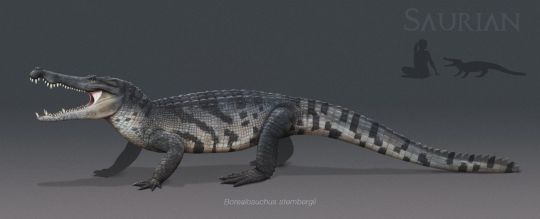
And the final two I shall talk about, both of which I thought/hoped would appear in the North America episode. Again, there's certainly overlap, both would have just as much fit into swamps, while many others would have also suited North America. Regardless, here's Brachychampsa (Tom Parker) and Borealosuchus (Chris Masna), both iconic animals from the Hell Creek Formation. One closely allied with alligators and caimans, the other more basal with a head-shape more similar to todays crocodiles.
Now obviously there'd have been a lot more. Part of the challenge to myself was to try and be as diverse as possible, rather than just listing 10 different baurusuchids I went with only two, tried to include as much of the world as possible, etc.... There's also the fact that some really awesome taxa, Titanochampsa, Brachiosuchus and Eurycephalosuchus, all incredibly unique or interesting, were published too late to have been considered for the show.
And now, in hinsight, we obviously know that with the exception of Simosuchus none of them made it in. Which is a shame, but maybe next time.
#prehistory#palaeblr#crocodile#paleontology#long post#prehistoric planet#prehistoric planet 2#borealosuchus#brachychampsa#simosuchus#pissarrachampsa#stratiotosuchus#gobiosuchus#ogresuchus#uberabasuchus#roxochampsa#armadillosuchus#adamantinasuchus#jiangxisuchus#denazinosuchus#sabinosuchus#rhabdognathus#chenanisuchus#mahajangasuchus#araripesuchus#acynodon#allodaposuchus#aprosuchus
157 notes
·
View notes
Text
While the Prehistoric Planet hype is still alive, I might as well express my desire for more and say what I'd personally love to see if they did a Season 3. I’ll put this under the cut because it’s a lot lol.
First thing's first, I'm going to be operating under the assumption we will be following the same format and setting, ie a few segments per episode set in the Masstrichtian stage of the Cretaceous with some loose overarching theme. I need to keep myself grounded in SOMETHING.
So first thing: I've already made fun of "North America" being the title of episode 2.5. What would fix this? If Season 3 did episodes centred on the other continents, of course! South America, Africa, Asia, Europe and... oh uh this might be a bit trickier. Specifically, where do Oceania and Antarctica go? Honestly, just do a vague "East Gondwana" episode for Madagascar, India, Antarctica and Zealandia.
"But we never saw anything from Appalachia!" True. Some generic "Islands 2" or "subcontinents" episode? But Antarctica isn't a subcontinent... maybe some "Atlantic" episode to combine with the European islands? Point is, it would still be messy. This isn't even my main idea, just a vague thought on how to structure Season 3 plus being salty that America gets its own episode (there weren't even any Canadian creatures lol).
OKAY enough fucking around, let's get to what I actually WANT to talk about, the stuff I'd actually want to see. Bring on the list!
Megaraptorids. We've seen representatives of all the large predatory theropods... except megaraptorids. A strange unique group of predators we don't even know where they fit in dinosaur cladistics, but seemed to be important in South American ecosystems. Orkoraptor actually comes from the same place as Dreadnoughtus so there's an easy excuse already, but I think it would be even more exciting to consider Maip. The size of this thing pretty much confirms they were apex predators, so definitely worth considering.
More notosuchians. It's wild how diverse they were, Simosuchus is just one of many species worth showing. Might as well mention Baurusuchids in particular, especially since they seem to have become significant predators in parts of South America. Dinosaur hunting crocs, guys.
Honestly? I'm down for crocodyliformes in general. Show us dyrosaurs in the seas, and even Eusuchians. Similar to modern crocs like Shamosuchus in Swamps, or something different like the more terrestrial Allodaposuchus.
More Europe weirdness! Whether it be Hateg fauna or stuff we know from other parts of the continent, I think people don't realise how unusual those ecosystems were, especially compared to Laurasia in general. Maybe I just want to see Magyarosaurus in detail, but also think about how Abelisaurs seem to be prominent terrestrial predators, for example? Also all the strange birds like Gargantuavis and maybe Balaur. Also, Asteriornis I see a lot of hype for. ;P
On a similar note, more stuff from Africa could be nice, especially terrestrial fauna! We know dinosaurs from Ouled Abdoun, which had fauna featured in Coasts and Deserts, and it's worth considering especially because you kind of see how some of these animals' ancestors may have led to similar species in nearby Europe. Also, if they ever further described more remains from the continent like that giant Kenyan abelisaur, that could provide cool opportunities.
This is a bit more out of left field but: non-ceratopsid ceratopsians. Leptoceratopsids, and even Protoceratopsids (hey, we have Velociraptor, we can make that stretch). Show how they're different from say Triceratops.
More non-hadrosaur ornithopods. Whether it be Thescelosaurus, more rhabdodontids, or some good ol Elasmarians from the Southern continents, I'd be down.
More India stuff is always fun, Deccan Traps FTW, could show other animals like noasaurs for that matter too.
Also Parankylosaurs, whether it be Stegouros with the macuahuitl, or an updated Antarctopelta (more Antarctica FTW).
Basically, even in terms of dinosaurs, show more stuff you've yet to do. Nodosaurs, Halzkaraptorines (again, see Velociraptor), heck even more of some groups we only briefly saw eg Alvarezsaurs and Pachycephalosaurs.
Honestly? More birds would be cool in general. I know we don't know much about a lot of them like Enantiornithines, but we could still try showing what we do know.
In terms of more familiar and recognisable stuff? I mean, you can't go wrong with well known species, but this is me wishing for stuff that's new. :P I will say though, if you want big names, we still haven't seen Ankylosaurus or Gallimimus...
Hmm, we haven't seen choristoderes, have we? In terms of other reptiles, not much comes to mind, nice we got to see Madtsoia in Islands at least.
Honestly more mammals could be fun. I'm pretty sure we have members of every modern group from the Maastrichtian somewhere (even monotremes, Patagorhynchus was recently described). Also diversity of lifestyles too.
Appalachia. More North America, but we see how life evolved somewhat differently on the eastern side of the continent and how it likely lacked some of the more recognisable animals we know from Laramidia.
I don't know enough about other groups to comment, so I'll leave it at that. Definitely got quite extensive, but honestly I'm all for exploring new places. Hell, look into invertebrates and fish I know heck all about (hmm I'm sure there's some cool sharks, right?).
Anyway, time to address the elephant in the room. What if the next season left the Maastrichtian, or we got a spin-off that did that? Well, I do have thoughts on that. For that, I could easily be SUPER biased and just name stuff that I personally want to see, but I think you'd need to think from the perspective of the higher ups too. In other words, what's gonna get the most eyes on the show? There's that, and also how well known the information of that time is, as well as considering things like cost and practicality. The Maastrichtian was chosen because it filled all three of those needs. You have iconic and charismatic species like T. rex, the Maastrichtian is very well studied and has sites from almost every continent, and because it's the closest to today, it's the easiest to film for.
I don't really know anything that would fit these three needs perfectly, ESPECIALLY in terms of filming locations (unless they wanna go majority CG, which I wouldn't mind personally but I know the production team likes real locations because of what they add to the show). But anyway, I have two possible eras as my main choices if they choose to do a similar kind of show: the Late Jurassic epoch (I'd name a specific stage but I don't know enough about them lol), and the Cenomanian stage at the start of the Late Cretaceous.
For the Late Jurassic (insert chosen stage of it here), you have a lot to work with. You have all the other most iconic traditional staple dinosaurs like Stegosaurus, Brontosaurus, Brachiosaurus and well known contemporaries like Diplodocus, Allosaurus, etc. In fact, the Morrison Formation is the main reason I opted for a Late Jurassic option. Sure, it does cover quite a bit of time, but we've seen Prehistoric Planet already take liberties with a six million year time span.
I think my main worry would be that some of the ecosystems on different continents might seem a bit similar, but honestly I doubt anyone would care too much. Plus, you have Asia with slightly different dinosaur groups, and Europe with their island ecosystems (eg Solnhofen). So even if it would be harder to film and some of the best locales for data are in more concentrated areas, I think there's enough to justify it. Also, novelty of early birds and birdlike dinos like Archaeopteryx.
As for the Cenomanian, you already have an easier time filming because angiosperms are now widespread, and you do have data from every continent. And while it doesn't have so many iconic species, there are a few, and some very charismatic animals to explore. Like, you have some of the biggest titanosaurs like Argentinosaurus. Massive Giganotosaurins who are built for hunting large sauropods. Everyone's favourite dinosaur, Spinosaurus. And again, stuff from almost every continent. Like, you could even have freaking Australia show up! Winton Formation is Cenomanian, so it could join the showcases of Africa, South America and others (I don't know so much about Cenomanian Laurasian fauna RIP). And while it would be true for the Late Jurassic as well, this time had especially peculiar nondinosaurs coexisting. Strange mammals. Giant freshwater fish. More unusual crocs. Even the earliest mosasaurs, all while ichthyosaurs and pliosaurs still existed. Basically, even if a layperson might only know Spinosaurus and Giganotosaurus from this time, you still have loads to potentially awe people with.
Anyway, that's a wrap on that. I have no clue what to expect for the future of Prehistoric Planet or what other upcoming palaeo docs will be like, but it's always fun to speculate!
16 notes
·
View notes
Video
youtube
Every creature in Dinosaur Planet
#dinosaurs#pyroraptor#velociraptor#protoceratops#oviraptor#dinosaur planet#iguanodon#notosuchus#daspletosaurus#shuuvia#saltosaurus#allodaposuchus#discovery channel#birds are dinosaurs#paleontology#animated#animated film#dinosaur movie#dinosaur show#plesiosaur#queztalcoatlus#aucasaur#land crocodile
1 note
·
View note
Text
Heptasteornis andrewsi

By José Carlos Cortés
Etymology: Transylvanian Bird
First Described By: Harrison & Walker, 1975
Classification: Dinosauromorpha, Dinosauriformes, Dracohors, Dinosauria, Saurischia, Eusaurischia, Theropoda, Neotheropoda, Averostra, Tetanurae, Orionides, Avetheropoda, Coelurosauria, Tyrannoraptora, Maniraptoromorpha, Maniraptoriformes, Maniraptora, Alvarezsauria, Alvarezsauroidea, Alvarezsauridae
Status: Extinct
Time and Place: Between 68 and 66 million years ago, in the Maastrichtian of the Late Cretaceous

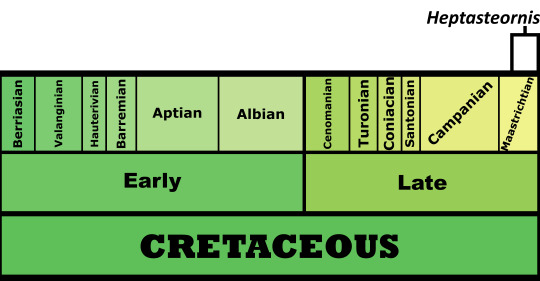
Heptasteornis is known from the Sânpetru Formation of Haţeg Basin

Physical Description: Heptasteornis is not very well known, poorly preserved to the point of it being uncertain what sort of dinosaur it actually was. It was some sort of small Maniraptoran - known from scattered remains, our best guess at the moment seems to be that it was an Alvarezsaur. As an Alvarezsaur, it would have been a small, fluffy animal - with very short arms, ending in a single finger with a sharp claw. It would have had long, skinny legs, and a long neck. Its head would have probably been small. Beyond that, specifics are unknown. It’s possible that it would have had small wings on its tiny arms - for display, and rather useless for anything else.
Diet: The diet of Alvarezsaurs is actually something of a question - assuming, of course, that Heptasteornis was one, it would probably match the other members of its group. One of the most popular hypotheses is that these dinosaurs are insectivores, but until more is known, we should probably go with the null hypothesis of omnivore.
Behavior: The behavior of Heptasteornis is a bit uncertain - not only because we don’t know what sort of dinosaur it is, but because the behavior of Alvarezsaurs is somewhat dubious. It used to be thought that they dug their way to food with their little claws, but that’s just one hypothesis. Regardless, Heptasteornis would probably have been a somewhat skittish, bird-like animal, energetic and using running as its main method of escape from danger. It also probably would have taken care of its young, and used feathers in both thermoregulation and display.
Ecosystem: Heptasteornis was part of the famed Haţeg Island Fauna, one of the weirder ecologies found right before the end of the Cretaceous period. This was a weird river environment on a small island, with a variety of ferns, moss, clubmoss, horsetails, ginkgos, and magnolia flowers. And there were weirdos in terms of animals - tiny dinosaurs, giant pterosaurs, the whole shebang. There were a wide variety of amphibians, turtles, lizards, snakes, and mammals there. There were also crocodyliformes like Allodaposuchus and Sabresuchus, some sort of large pterosaur, and other dinosaurs like the fast-moving ankylosaur Struthiosaurus, the large hadrosaur-like Telmatosaurus, the Rhabdodont Zalmoxes, the small titanosaur Magyarosaurus, another Alvarezsaur by the name of Bradycneme, a miscellaneous maniraptoran called Elopteryx, and a troodontid named Euronychodon.
Other: Heptasteornis was originally thought to be a bird - hence the name - before its current classification as an Alvarezsaur. Still, pretty bird-like in the end. It is one of the first Alvarezsaurs (probably) that was found in Europe.
~ By Meig Dickson
Sources under the Cut
Andrews, C.W. (1913): On some bird remains from the Upper Cretaceous of Transylvania. Geological Magazine 5: 193-196.
Csiki, G. & Grigorescu, D. (1998): Small theropods from the Late Cretaceous of the Hateg Basin (western Romania) - an unexpected diversity at the top of the food chain. Oryctos 1: 87-104.
Harrison, Colin James Oliver & Walker, Cyril Alexander (1975): The Bradycnemidae, a new family of owls from the Upper Cretaceous of Romania. Palaeontology 18(3): 563-570.
Holtz, Thomas R., Jr. (2007). "Ornithomimosaurs and Alvarezsaurs". Dinosaurs: The Most Complete, Up-to-Date Encyclopedia for Dinosaur Lovers of All Ages.
Le Loeuff, J.; Buffetaut, E.; Méchin, P. & Méchin-Salessy, A. (1992): The first record of dromaeosaurid dinosaurs (Saurischia, Theropoda) in the Maastrichtian of southern Europe: palaeobiogeographical implications. Bulletin de la Société géologique de la France 163(3): 337-343.
Naish, Darren & Dyke, Gareth J. (2004): Heptasteornis was no ornithomimid, troodontid, dromaeosaurid or owl: the first alvarezsaurid (Dinosauria: Theropoda) from Europe. Neues Jahrbuch für Geologie und Paläontologie Monatshefte 7: 385-401.
Paul, Gregory S. (1988): Predatory Dinosaurs of the World. New York, Simon & Schuster.
Weishampel, D.B.; Grigorescu, D. & Norman, D.B. (1991): The dinosaurs of Transylvania. National Geographic Research and Exploration 7(2): 196-215.
Weishampel, David B.; Dodson, Peter; and Osmólska, Halszka (eds.): The Dinosauria, 2nd, Berkeley: University of California Press. 861 pp.
#Heptasteornis andrewsi#Heptasteornis#Alvarezsaur#Maniraptoran#Dinosaur#Dinosaurs#Prehistoric Life#Prehistory#Paleontology#Omnivore#Insectivore#Feathered Dinosaurs#Eurasia#Cretaceous#Mesozoic Monday#biology#a dinosaur a day#a-dinosaur-a-day#dinosaur of the day#dinosaur-of-the-day#science#nature#factfile
130 notes
·
View notes
Text
im rewatching Dinosaur Planet and this is the first time ive noticed how prevalent model reuse is in it
the crocodilians in Pod’s Travels and Alpha’s Egg are the same model, but it seems like the model is made for the Notosuchus in Alpha’s Egg, because it doesn’t look much like Allodaposuchus
#the Saltasaurus model is also used for both the big titanosaurs and the Magyarosaurus in Pod's Travels#Pod's Travels in general is kinda a weak link in the program; most of it doesn't hold up to modern interpretations of the fossils#and some of it like the dwarf abelisaurs is just plain fictitious
3 notes
·
View notes
Text
Tweeted
New paper: Phylogenetic status of some fossils assigned to Allodaposuchus #cretaceous #crocodiles #eusuchia https://t.co/0UuCmDxQO0 http://pic.twitter.com/XL39LdaH8C
— Francisco Ortega (@frco_ortega) July 5, 2017
0 notes